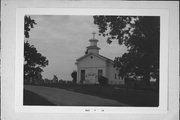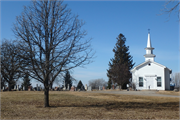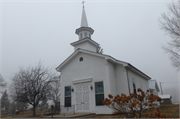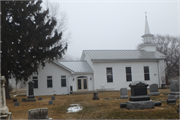Property Record
479 Clairville Rd
Architecture and History Inventory
| Historic Name: | |
|---|---|
| Other Name: | Bethesda Presbyterian Church |
| Contributing: | |
| Reference Number: | 69162 |
| Location (Address): | 479 Clairville Rd |
|---|---|
| County: | Winnebago |
| City: | |
| Township/Village: | Nekimi |
| Unincorporated Community: | Ring |
| Town: | 17 |
| Range: | 16 |
| Direction: | E |
| Section: | 30 |
| Quarter Section: | SW |
| Quarter/Quarter Section: | SW |
| Year Built: | |
|---|---|
| Additions: | |
| Survey Date: | 19772022 |
| Historic Use: | house of worship |
| Architectural Style: | Greek Revival |
| Structural System: | |
| Wall Material: | Clapboard |
| Architect: | |
| Other Buildings On Site: | |
| Demolished?: | No |
| Demolished Date: |
| National/State Register Listing Name: | Not listed |
|---|---|
| National Register Listing Date: | |
| State Register Listing Date: |
| Additional Information: | The inventoried structure is a Greek Revival style church. The construction date was not available in the WHPD. It is located on the northwest side of County Highway YY (Clairville Road), 1.8 miles southwest of County Highway N, and approximately 500 feet east of James Road in Winnebago County. The Bethesda Presbyterian Church was first inventoried in the WHPD in 1977. The Oshkosh Public Library’s Pioneer Churches collection includes historical information about the Bethesda Presbyterian Church, which is noted as significant because it is the “last active church of Welsh heritage in [the] area.” The first Welsh religious service in the area was performed in 1846 when “nine Welshman rode a lumber wagon from Waukesha” to where they had “obtained plats of land in” Eldorado, Nekimi, and Utica townships. The first Welsh congregation was called Bethesda; its chapel was built in 1849 but was replaced in 1856 by the present church building. The denomination was originally Calvanistic Methodist, which became known as Welsh Calvinistic Methodist Churches by 1920, and in 1955 “they united with the Presbyterian Church (USA).” This congregation was one of five Welsh churches in the rural area in 1897, but “by 1947 only two remained, Bethesda and Peniel,” which shared a minister as the size of congregations declined throughout the first half of the twentieth century. Welsh-speaking ministers led services into the 1930s. Peniel closed after 1977, and many of its twenty remaining congregants became members of the Bethesda parish (Oshkosh Library n.d.). The library’s building file on the church notes that the church has “modern facilities with limited historic elements remaining.” The file is undated, and its primary source is a 1996 history of Welsh-rooted churches outside of Britain. It notes that alterations “in recent years” included replacing the “church’s steeple […] with a spire and cross,” installation of a modern furnace to replace “the old-fashioned stoves in the rear of the church,” and “a basement was built under the church for pot-luck suppers and business meetings” (Oshkosh Library n.d.). It is unclear when those alterations took place. The 1974 photograph in the WHPD shows the spire and cross, but the church presently has a steeple, indicating it was altered again later (or the library text misstated the alterations). The photograph also shows front entryway has been enlarged; in 1974 a broken arch pediment surmounted a pair of wooden doors and did not rise above the top 1/3 of the flanking windows. At the time of this survey, the top of the entryway is nearly in line with the top of the windows; a pair of new doors have a covered panel overhead, along with a flat pediment. Aerial photographs indicate the rear addition was added after 1986. At the time of survey, the church had undergone further changes, but with modern materials in keeping with its historic appearance, including narrow vinyl lap siding and storm windows over historic stained glass. The church is located next to Bethesda Welsh Cemetery. This cemetery is divided into four sections; three long and narrow sections contain older graves while a larger section of more recent graves runs along the south end of the other sections. The cemetery was not considered when evaluating the integrity and significance of the church but should be included with future research |
|---|---|
| Bibliographic References: | Oshkosh Public Library n.d. “Pioneer Churches” Local history collection. Online resource, https://www.oshkoshpubliclibrary.org/localhistory/pioneerchurches and https://box2.nmtvault.com/Oshkosh/jsp/RcWebSearchResults.jsp, accessed March 2022. Swierenga, Robert P. 1997 “The Little White Church: Religion in Rural America.” Agricultural History. Vol. 71, No. 4 (Autumn, 1997), pp. 415-441. Online resource, https://www.jstor.org/stable/3744470, accessed November 2022. Wisconsin Historical Society (WHS) 1854 "'Little White Church On the Hill' (Ripon, Wis.).” Illustration (Image ID 39591). Artist unknown. Digitized and hosted by WHS. Online resource, https://www.wisconsinhistory.org/Records/Image/IM39591, accessed November 2022. |
| Wisconsin Architecture and History Inventory, State Historic Preservation Office, Wisconsin Historical Society, Madison, Wisconsin |




